According to widely accepted fluid mosaic model cell membranes are semi-fluid, where lipids and integral proteins can diffuse randomly. In recent years, this model has been modified in several respects. In this regard, which of the following statements is incorrect?
Proteins in cell membranes can travel within the lipid bilayer.
Proteins can also undergo flip-flop movements in the lipid bilayer.
Proteins can remain confined within certain domains of the membrane.
Many proteins remain completely embedded within the lipid bilayer.
Correct Answer :
B. Proteins can also undergo flip-flop movements in the lipid bilayer.
The quasi-fluid nature of lipid enable lateral movement of proteins within the overall bilayer. This ability to move within the membrane is measured as its fluidity.
Related Questions
Which one of the following organelle given below is correctly matched with its function ?
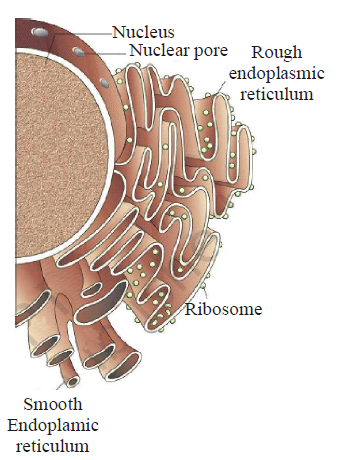
Golgi apparatus Protein synthesis
Golgi apparatus Formation of glycolipids
Rough endoplasmic reticulum Protein synthesis
Rough endoplasmic reticulum Formation of glycoproteins
Active transport differs from passive transport in that active transport
requires energy.
always requires input of ATP.
moves molecules against a concentration gradient.
both (a) and (c)
Difference between the prokaryotic and eukaryotic cells in having
cell wall
nuclear membrane
ribosome
none of these
Select the statements which are related to Schwann.
- He reported that cells have a thin outer layer which is today known as plasma membrane
- Cell wall is a unique character of the plant cell.
- Body of plants and animals are composed of cells and products of cells.
Only (i)
Only (iii)
(i) and (iii)
All of these
Polysome is a chain of
oxysomes
sphaerosomes
ribosomes
dictyosomes
Which of the following will determines the shape of the cells and provides a strong structural support to prevent the bacterium from bursting or collapsing?
Plasmids
Cell wall
Mesosome
Cell membrane
In which of the following the cells are held together by a Ca-pectate layer?
Primary cell wall
Secondary cell wall
Middle lamella
Tertiary cell wall
Which of these is wrongly matched?
Chloroplasts Chlorophyll
Elaioplasts Starch
Chromoplasts Carotenoids
Amyloplasts Carbohydrates
Which of the following statements are correct?
Na+/K+ pump is an example of active transport.
In plant cells lipid like steroidal hormones are synthesized in SER.
In plant cells, the vacuoles can occupy up to 10% of the volume of the cell.
Chlorophyll and leucoplast are responsible for trapping light energy essential for photosynthesis.
Membranous extensions in blue green algae are known as
phytochrome
chromatophore
mesosome
pneumatophore
Select the incorrect statement about prokaryotic ribosomes.
50S and 30S subunits unite to form 70S ribosomes.
Polysome/polyribosome consists of many ribosomes only.
Ribosome is the site of protein synthesis.
Polysome indicate the synthesis of identical poolypeptide in multiple copies.
Which of the following option correctly match A, B, C, and D indicated in the given sectional view of chloroplasts.

A - Thylakoid, B-Stromal lamella, C - Stroma, D - Granum
A - Granum, B - Thylakoid, C - Stromal lamella, D - Stroma
A - Thylakoid, B - Granum, C - Stromal lamella, D - Stroma
A - Granum, B - Thylakoid, C - Stroma, D - Stromal lamella
Which of the following terms is not correctly matched with its feature?
Osmosis Movement of water by diffusion.
Nucleoplasm Site of active synthesis of ribosomal RNA.
Mesosome Infolding of cell membrane and characteristics of eukaryotes.
Pili Elongated tubular surface structures (made of special protein) of bacteria.
The given diagram shows the sectional view of a mitochondrion.

Identify the parts labelled as A, B, C, D & E
A - Outer membrane, B - Inner membrane, C - Matrix, D - Inter- membrane space, E - Crista
A - Outer membrane, B - Inner membrane, C - Intermembrane space, D - Matrix, E - Crista
A - Outer membrane, B - Inner membrane, C - Matrix, D - Crista, E - Inter - membrane space
A - Outer membrane, B - Inner membrane, C- Crista, D - Matrix, E - Inter-membrane space
You are asked to examine a cell using a powerful light microscope. The image you see has a clearly defined nucleus and mitochondria. It also has a large central vacuole and chloroplasts. From what group of organisms did this cell most likely come?
Bacteria
Protists
Fungi
Plants
Golgi apparatus is concerned with
excretion
secretion
ATP synthesis
RNA synthesis
Nucleolus is
rounded structure found in cytoplasm near nucleus.
rounded structure inside nucleus and having rRNA.
rod-shaped structure in cytoplasm near the nucleus.
none of the above.
The lipid component of the membrane mainly consists of __________.
polysaccharides
phosphoglyceride
monosaccharaides
both (a) and (c)
Match the items given in column-I with their role given in column-II and choose the correct option.
| Column-I | Column-II |
|---|---|
| A. SER | I. Increase the surface area |
| B. Golgi apparatus | II. Store oils or fats |
| C. Cristae | III. Excretion |
| D. Peroxisome | IV. Photorespiration |
| E. Elaioplasts | V. Synthesis of lipid |
A V; B III; C I; D IV; E II
A V; B III: C II; D IV; E I
A II; B III; C I; D IV; E V
A III; B IV; C I; D V; E II
Match column-I and column-II and select the correct answer
| Column-I | Column-II |
|---|---|
| A. Bacteria without walls | I. Lysosome |
| B. Small circular DNA | II. Mycoplasma cells |
| C. Flattened sacs in | III. Thylakoid a chloroplast |
| D. A vesicle in which | IV. Plasmid hydrolytic enzymes are stored |
A III; B IV; C II; D I
A II; B IV; C III; D I
A I; B II; C III; D IV
A IV; B III; C I ; D II
Centrioles and centrosomes occur in the cells of
green plants
animals
bacteria and cyanobacteria
both (b) and (c)
According to widely accepted fluid mosaic model cell membranes are semi-fluid, where lipids and integral proteins can diffuse randomly. In recent years, this model has been modified in several respects. In this regard, which of the following statements is incorrect?
Proteins in cell membranes can travel within the lipid bilayer.
Proteins can also undergo flip-flop movements in the lipid bilayer.
Proteins can remain confined within certain domains of the membrane.
Many proteins remain completely embedded within the lipid bilayer.
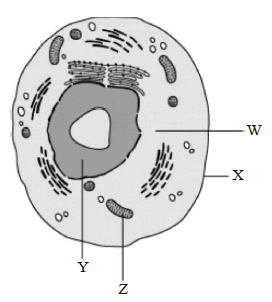
Which function is carried out by the cell organelle 'X'?
helps control the movement of substance in and out of the cell
passes information from the parent cell to newly formed cell
maintains the proper shape of the cell and serves as a protective barrier
helps the cell to make food with the help of chlorophyll and sunlight
Chromosomes having equal or almost equal arms are called
metacentric
acrocentric
polycentric
acentric.
Which of the following pair are correctly matched.
A. Microtubules Structural components of cilia
B. Centrioles Store hydrolytic enzymes
C. Amyloplasts Store oil protein and starch in plants
A, B and C
A and B
A
A and C
In the given figure of animal cell, one orginelle is marked as A. Select the correct identification and function of the organelle A from the given option.
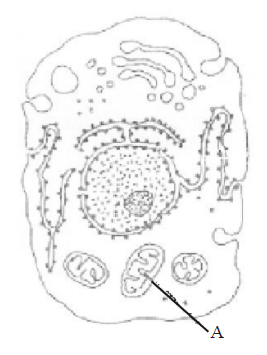
Endoplasmic reticulum Synthesis of lipids.
Mitochondria Produce cellular energy in the form of ATP.
Golgi body Provides packaging material.
Lysosomes Secrete hydrolytic enzymes.
The following diagram shows some of the missing structures in a plant cell marked as A, B, C, D E. Choose the option with their correct names.
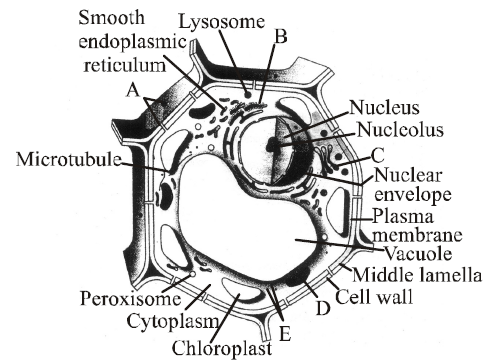
A - Plasmodesmata, B - Rough endoplasmic reticulum, C - Golgi apparatus, D - Mitochondrion, E - Ribosomes
A - Desmosome, B - Rough endoplasmic reticulum, C - Golgi apparatus, D - Mitochondrion, E - Ribosomes
A - Plasmodesmata, B - Smooth endoplasmic reticulum, C - Golgi apparatus, D - Mitochondrion, E - Ribosomes
A - Tight junction, B - Rough endoplasmic reticulum, C - Golgi apparatus, D - Mitochondrion, E -Ribosomes
Which one of the following pairs is not correctly matched?
Cristae The tubular structure formed by the folding of the inner membrane of the mitochondrion.
Plasmodesmata The membrane surrounding the vacuole in plants.
Grana Membrane bound discs in chloroplasts that contain chlorophylls and carotenoids.
Middle lamella Layer between adjacent cells walls in plants derived from cell plate.
Identify the components labelled as A, B, C, D and E in the diagram given below from the list (i) to (viii).
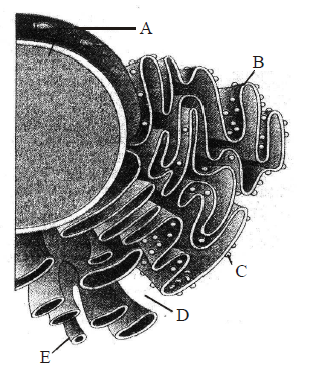
- Cristae of mitochondria
- Inner membrane of mitochondria
- Cytoplasm
- Smooth endoplasmic reticulum
- Rough endoplasmic reticulum
- Mitochondrial matrix
- Ribosome
- Nucleus
A - (viii), B - (v), C - (vii), D - (iii), E - (iv)
A - (i), B - (iv), C - (vii), D - (vi), E - (iii)
A - (vi), B - (v), C - (iv), D - (vii), E - (i)
A - (v), B - (i), C - (iii), D - (ii), E - (iv)
The given figures show two types of cell. Which structures are common to both the cells?

Nucleus and cell wall
Nucleus and cytoplasm
Ribosomes and flagella
Ribosomes and cell wall
